The summer transfer window officially kicked off on the 27th July 2020 but no one would have predicted the speed at which Chelsea would go about their business. Chelsea have agreed to a deal to sign Bayer Leverkusen’s Kai Havertz after activating his buyout clause. While a player in his position was not a priority by any means, the opportunity to sign the best young talent in world football with no real competition doesn’t come very often. This scout report will look to understand Havertz’s style of play and how he fits into Chelsea’s tactics. Through tactical analysis, using data and footage, we will determine how he can improve Chelsea’s attacking style of play.
Positioning & role
Havertz is a dynamic, quick, attacking midfielder capable of playing in multiple positions. His versatility is what makes him such a unique player especially since he is extremely consistent wherever he plays. A natural attacking midfielder, Havertz can play as a centre-forward, right-winger, and central midfielder. Bayer Leverkusen actively used the 4-2-3-1 formation (40%) with other systems such as the 4-4-2 and 3-4-2-1 were used sparingly (9% & 8%). Havertz was used across the three aforementioned positions but majorly at right-wing.
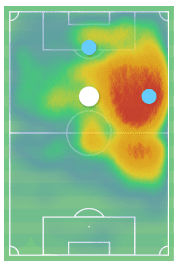
It’s hard to pinpoint Havertz’s exact role but he plays a hybrid of a playmaker and box-to-box role where he can link-up play but also attack the box with late runs by finding pockets of space. Even though the majority of his play time has come at right-wing his play style is dynamic and malleable enough to play those three positions well. His heat map is indicative of his preferred areas and what is most prominent is his preference to play in both the central and wide areas. We can also see activity in the 18-yard box which comes from his late runs when he plays in central midfield. Havertz has excellent timing and his runs into the box often result in him finding space to latch onto a cut-back or cross.
The skillset he has translates to the position he plays in and through this scout report, we will examine his skills and attributes and how they can be used in Chelsea’s tactics.
In possession – Link-up play
One of the hallmarks of Havertz’s game is his ability to link-up play. We know that his style of play is one that involves constant movement and positional rotations where Havertz will drop off to pick up or receive possession and interchange passes with nearby attacking teammates. With quick one-touch passing, Havertz is able to move into space quickly without having the ball for too long, which forces opposing defenders to adapt quickly and anticipate his intentions. This stems from high footballing intelligence and IQ where the player has the positional awareness to know where the opposition and his teammates are positioned.
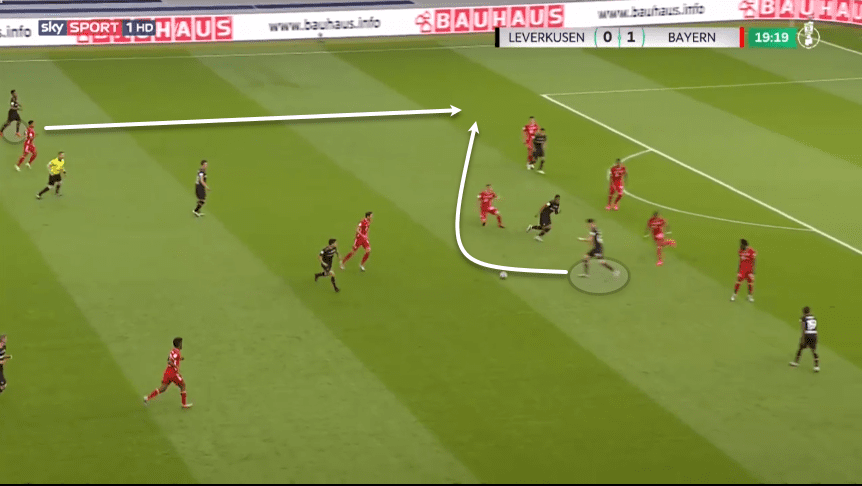
Havertz’s link-up play can be seen in the above example, where he drops deep from his central position to pick possession. In doing so, the Bayern Munich centre-back follows him opening up a gap in behind. Havertz’s intention is to play a through ball towards the far sided Bayer Leverkusen player. Once he makes the pass, he immediately turns and finds space in the 18-yard box. As a by-product, Havertz pulling away from the centre-back also allows his near sided teammate space to run in behind.
Looking at his statistics, Havertz averages 4.45 passes to final third and 37.23 received passes which means he not only makes a healthy number of forward-thinking passes but is a player that links play in the final third. It also tells us about his ability to be trusted by his teammates to receive the ball frequently and keep the ball at his feet. If we examine the pass maps below we can see he tends to prefer the right half-space regardless of position. From here notice that his passing links with teammates are very prominent is able to get into close contact with the other forwards and attacking midfielders.

The example below against Bundesliga rivals Wolfsburg gives us another indication of his link-up ability. Havertz was deployed as the central striker. When playing as the centre-forward his playstyle resembles that of Liverpool‘s Roberto Firmino where he does most of his work off the ball and creates opportunities for his wide forwards. Here Havertz drops deep into his defensive third to give his teammate a passing option with Wolfsburg retreating back into their defensive third. He understands that his attacking teammate is in a better position and more likely to take advantage of the space in behind.
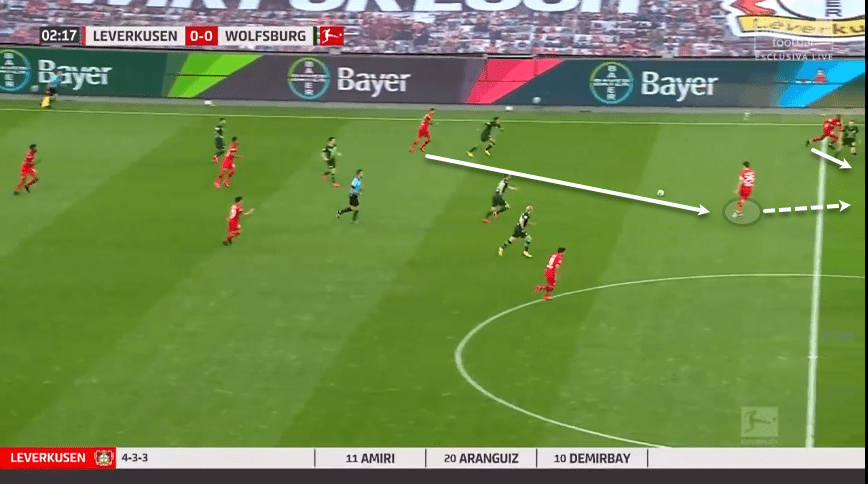
Chelsea’s attacking movement revolves around constant ball rotations and movement by the forward players. The centre-forward uses more vertical movement to link up play because they need to be in and around the 18-yard box to receive a final pass or cross. This is why the recruitment of Timo Werner makes sense and the success of Olivier Giroud and Tammy Abraham has already showcased this. Havertz’s link-up play fits in perfectly with Chelsea’s tactics and how Lampard wants his forward-thinking players to operate. The 4-3-3 system Chelsea use will allow one of Mason Mount or Havertz to push forward into the box after interchanging passes and make late runs into the box.
Vision & creativity
A lot of Frank Lampard’s system is predicated on movement and quick decision making between the forwards. Havertz’s spatial awareness and off the ball movements will be a good fit in Chelsea’s system. His ability both on and off the ball is exceptional and is what his main game is based around. Along with this, his movement through his dribbling and shot selection makes him an excellent midfielder. What is also complimentary about this is his creativity and vision to be one step ahead. His passing has been a hallmark of his play for Bayer Leverkusen which has made him an excellent playmaker on the ball too. While we will cover Havertz off the ball understanding and movement in further detail later, Havertz’s passing is another part of his game that was heavily used by Leverkusen.
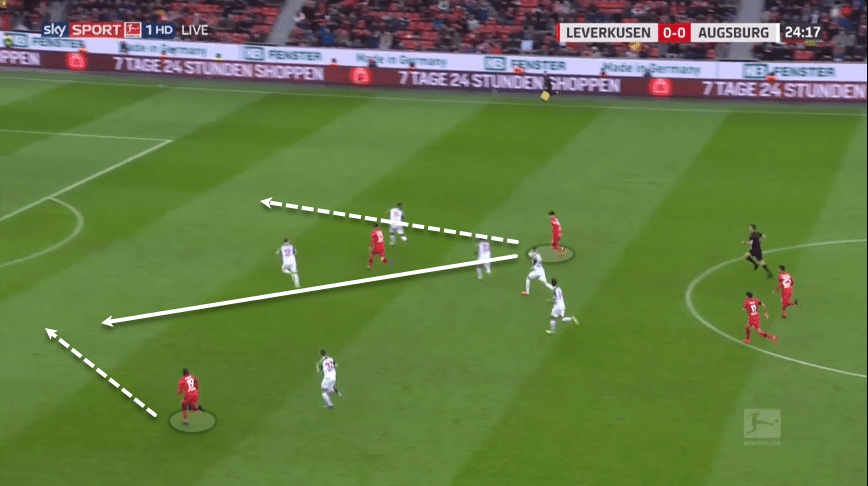
This passage of play exemplifies both Havertz’s quick decision making and creativity. We can see Leverkusen counter-attacking Augsburg with Havertz presented with two options in front of him.
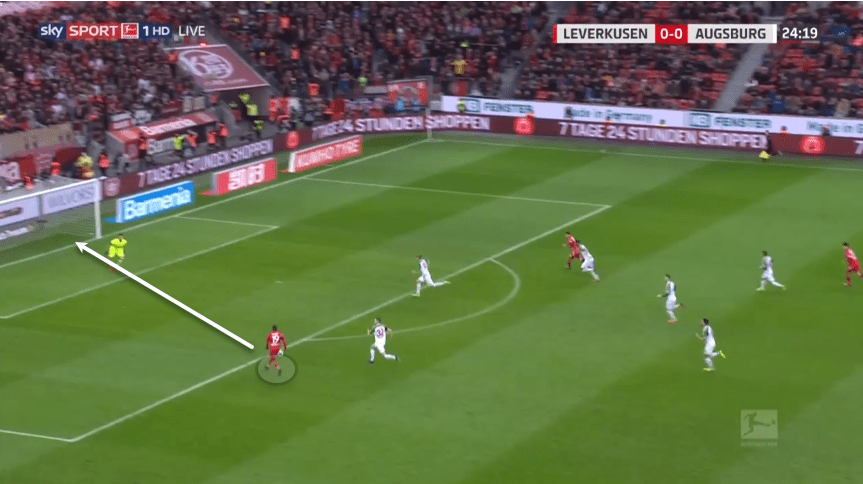
He could very easily slide a pass to his right for his teammate closest to him to pick up on, however, he sees a gap between the Augsburg players and manages to slip a perfectly weighted pass to Moussa Diaby who is in acres of space. This pass has created a 1 vs 1 opportunity and a clear goal-scoring chance for Diaby.
While he only averaged 1.05 through passes/90, Havertz has a success rate of 50%. This could be a mixture of the inaccuracy of passing but also his teammates not able to reach the pass. Havertz ranked 19th for key passes/90 and 21st for deep completions in the Bundesliga last season proving that even though his game revolves around being a box-to-box midfielder, he is equally capable of mixing it up as one of the better progressive and creative passers in the league.
Chelsea’s main creative outlet in midfield comes from Jorginho who plays as the number ‘6’. Adding Havertz into a central midfield position will not only ease the creative burden off Jorginho but also allow Lampard to make tactical alterations by playing N’Golo Kante there. We saw Kante’s effect as the defensive midfielder after the restart against Aston Villa and Manchester City. While it gave Chelsea a bit more defensive solidarity, they were void of creativity going forward. Against Manchester City, this would have been a deliberate ploy, but this could serve as a potential way of playing going forward with Jorginho falling slightly out of favour. Havertz’s introduction opens up a few possibilities.
Out of possession
At the age of 21, Havertz is already one of the most intelligent midfielders in world football. The positional awareness and understanding of the midfielder aids his decision-making and more often than not his intentions are correct. Havertz is excellent at making late runs into the box even more so when he combines his passing and link-up play to finish an attacking move. These late runs are usually done when the opposing teams are focused on the other attacking players in and around the 18-yard box. This allows him to ghost through unnoticed finding space to attack the ball. Being proficient in both ground and aerial crosses make him a very dangerous proposition in the box which will only benefit Chelsea’s wide players.
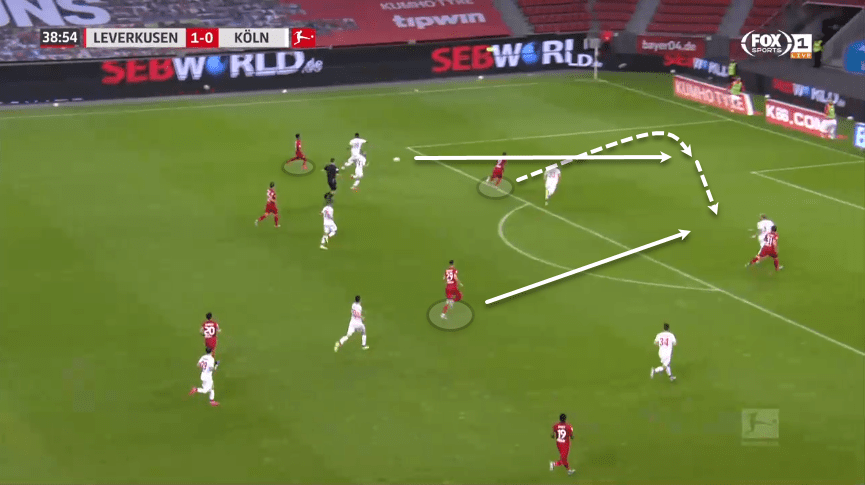
Here against Koln, we can see Leverkusen attacking down their left with Havertz situated in the middle. He understands that a cross will be coming but is not eager to make his run too early to overrun the cross or alert the centre-back of his presence. He accelerates as the ball gets closer to being crossed and manages to score.
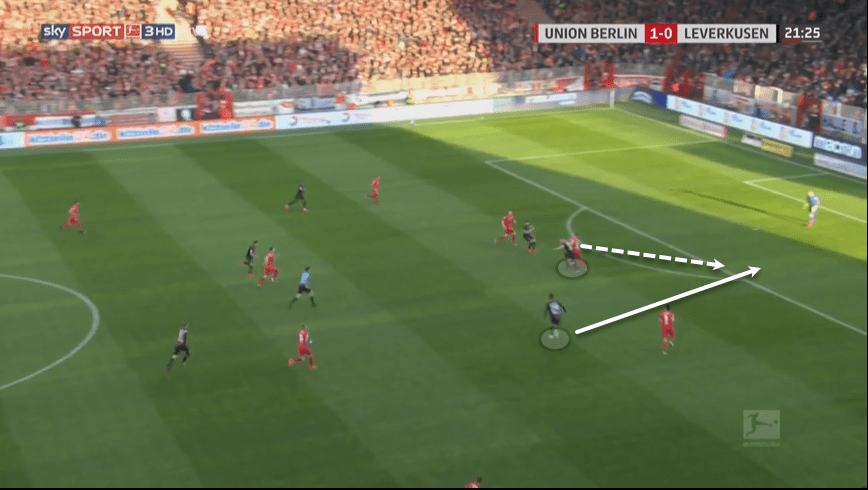
Another example here can be seen where Havertz’s initial position is on the right, but as the long pass comes in towards his centre-forward, we can see Havertz make an inward movement towards the box. He is already gambling on making a run in the event the striker wins the aerial duel.
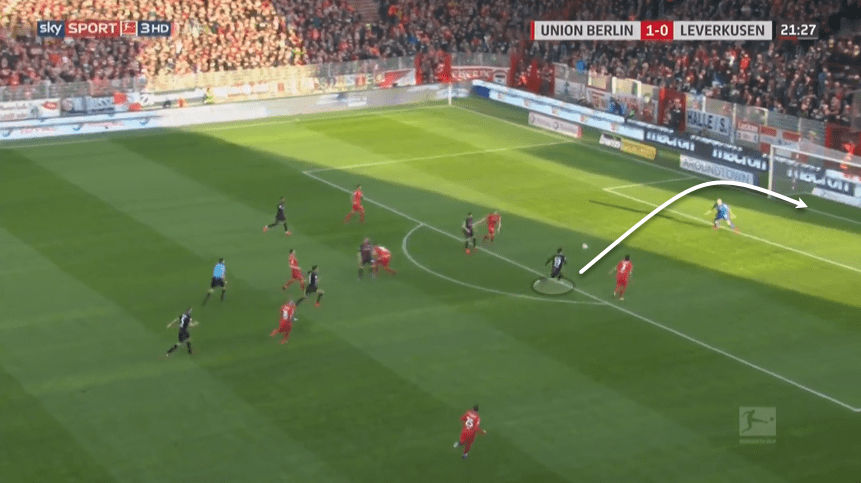
His centre-forward does win the duel and Havertz manages to get to the ball first and lob it over the goalkeeper. The awareness to make the run from Havertz comes from his confidence and knowing the system. Playing with a centre-forward that he can play off of is vital and having a player like Giroud makes for a very intriguing partnership, one that could yield excellent results for Chelsea.
How does Kai Havertz fit into Chelsea?
Lampard’s Chelsea have a very fluid and attacking style of play. The current system revolves around a possessional 4-3-3, but they have also used a 4-2-3-1 and 3-5-2 as tactical alternatives. The use of different formations is to allow Lampard the flexibility to adapt to the opposition and not become predictable. However, their overall structure remains consistent throughout each system. Most of the players are centrally located and the full-backs are the widest players on the pitch in this 4-3-3 in the pass map below
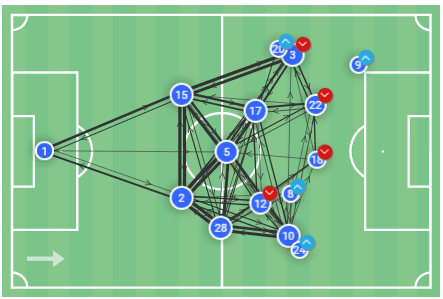
When it comes to Havertz, Lampard can play him in a few different positions including right-wing, central midfield, or attacking central midfield. The option to play him as a false nine is another option if he wishes to change things up. However, Havertz should take up one of the three central midfield positions, namely the right side, which would be the position Ruben Loftus-Cheek (#12) has taken up in the pass map above. That is from Chelsea’s game against Norwich a few weeks ago, and what is interesting to see is the number of passing links between Loftus-Cheek, Willian (#10), Cesar Azpilicueta (#28), and Jorginho (#5). Havertz would play in this position and have access to Chelsea’s core attacking and creative contingent. Havertz’s strengths as we’ve seen throughout this analysis is predicated on his movement, understanding with his teammates and decision-making.
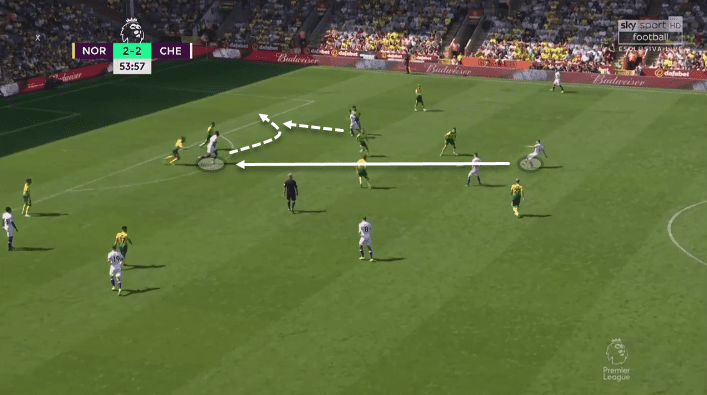
Chelsea often struggled to break down low-block defences and had to rely on persistence and most often the movement combinations of the forward players where the striker was key. Abraham is marked by two centre-backs which takes the focus away from Barkley on the far side. Jorginho sees Barkley in a good position and instead of playing a direct pass that could be intercepted, he finds Abraham who drops deep and plays in a quick through ball for Barkley to open up space in behind the two centre-backs. Havertz is excellent at making similar runs and as we saw in the earlier example, is more than willing to gamble on runs in behind.
All these attributes are key to what Lampard wants in a central midfielder making Havertz a dream signing. His signing might signal the need to shift someone out because Chelsea have a number of options there with Ross Barkley, Loftus-Cheek, Kante, Jorginho, Kovačić, Billy Gilmour, and Mount all vying for a spot but each player brings their own capabilities to the table. Lampard will need to assess who he needs to keep at Stamford Bridge and whether or not he can give everyone sufficient game time.
Final remarks
While Chelsea are well stocked in the position, signing a player of his calibre without too much competition doesn’t always come. The last time Chelsea made a similar purchase, they managed to extract eight years from one of the best wingers in world football who goes by the name of Eden Hazard. Likened to Michale Ballack, Havertz is physically and technically gifted that he can be a success in any position he’s played in. Havertz should be a long term success and his signing is another indication that Chelsea are ready to establish themselves as one of Europe’s premier destination for young talent that will be given a chance in the first team if they are up to par. The rumoured signings of Thiago Silva and Ben Chilwell along with Havertz is a major statement which has put Chelsea at the forefront of the league in terms of doing their business early.






Comments